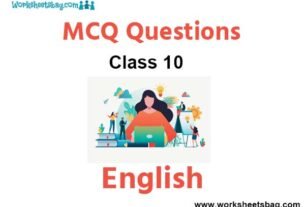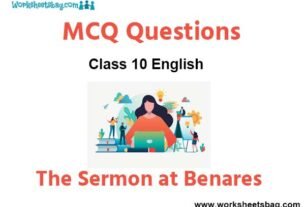Please refer to Carbon and Its Compound MCQ Questions Class 10 Science below. These MCQ questions for Class 10 Science with answers have been designed as per the latest NCERT, CBSE books, and syllabus issued for the current academic year. These objective questions for Carbon and Its Compound will help you to prepare for the exams and get more marks.
Carbon and Its Compound MCQ Questions Class 10 Science
Please see solved MCQ Questions for Carbon and Its Compound in Class 10 Science. All questions and answers have been prepared by expert faculty of standard 10 based on the latest examination guidelines.
Question. For gas welding used for welding broken pieces of iron, we normally use a mixture of
(a) Ethane and oxygen
(b) Ethene and oxygen
(c) Ethyne and oxygen
(d) Ethene and air
Answer
A
Question. Major constituent of LPG is……………
(a) Ethene
(b) Butane
(c) Propane
(d) Pentane
Answer
B
Question. Which of the following is used to oxidise ethanol to ethanoic acid?
(a) Alkaline KMnO4
(b) Conc. H2SO4
(c) Acidified K2Cr2O7
(d) All of above
Answer
D
Question. Carbon compounds with single bond called……….
(a) Unsaturated compound
(b) Carbon compounds
(c) Saturated compounds
(d) Ionic compounds
Answer
C
Question. Ionic compounds have does not show below property.
(a) High melting point
(b) High boiling point
(c) Conduction of electricity in solid state
(d) Conduction of electricity in molten state
Answer
C
Question. Which of the given is a noble gas?
(a) Carbon
(b) Argon
(c) Nitrogen
(d) Hydrogen
Answer
B
Question. Which of the following can be used for the denaturation of ethyl alcohol?
(a) Methyl alcohol
(b) Pyridines
(c) Copper sulphate
(d) All of above
Answer
D
Question. Which of the given has a triple bond?
(a) Hydrogen molecule
(b) Oxygen molecule
(c) Nitrogen molecule
(d) Ammonia molecule
Answer
C
Question. A hydrocarbon has four carbon atoms. Give its molecular formula if it is an alkene.
(a) C4H10
(b) C4H8
(c) C4H6
(d) C4H4
Answer
B
Question. Soaps are formed by saponification of
(a) Alcohols
(b) Glycosides
(c) Simple esters
(d) Carboxylic acids
Answer
C
Question. A hydrocarbon should have a minimum of how many carbon atoms to show isomerism?
(a) Three
(b) Four
(c) Fived
(d) Six
Answer
B
Question. Give the IUPAC name of CH3COOC2H5.
(a) Ethyl ethanoic acid
(b) Butanoate
(c) Ethyl ethanoate
(d) Etyl methyl carboxylic acid
Answer
C
Question. A carbon compound contains two atoms of carbon. Which name should the carbon compound bear?
(a) Butane
(b) Ethane
(c) Methane
(d) Propan
Answer
B
Question. The upper and lower homologue of C2H5OH are respectively
(a) methyl alcohol and butyl alcohol
(b) ethyl alcohol and propyl alcohol
(c) butyl alcohol and propyl alcohol
(d) propyl alcohol and methyl alcohol
Answer
D
Question. Sodium reacts with ethanol gives …………
(a) Sodium ethoxide
(b) Sodium ethanoate
(c) Sodium ethanol
(d) Sodium hydroxide
Answer
A
Question. ………….has sweet flavoring substance which used in ………….
(a) Ester, metals
(b) Ethers, sweet mithai
(c) Aldehyde, metals
(d) Ester, perfumes
Answer
D
Question. Which of the given is not an aliphatic hydrocarbon?
(a) Ethene
(b) Ethane
(c) Propyne
(d) Benzen
Answer
D
Question. Methane, ethane and propane are said to form a homologous series because all are-
(a) Hydrocarbons
(b) saturated compounds
(c) aliphatic compounds
(d) differ from each other by a CH2 group
Answer
D
Question. C2H2 Called………..
(a) Ethyne
(b) Butane
(c) Ethane
(d) Propene
Answer
A
Question. Read The Following Sentences Carefully, And Choose The Incorrect One:
(a) Normal-butane has a straight chain structure whereas iso-butane has a branched chain structure.
(b) All the members of a homologous series can be represented by the different formula.
(c) Isomerism is possible only with hydrocarbons having 4 or more carbon atoms.
(d) The organic compounds having the same molecular formula but different structures are known as isomers.
Answer
B
Question. A reagent which can help us to distinguish between alkenes and alkynes is:
(a) Bromine water
(b) Carbon tetrachloride
(c) Alkaline KMnO4
(d) Ammoniacal cuprous chloride
Answer
D
Question. Which of the given is used to oxidise ethanol to ethanoic acid?
(a) Alkaline KMnO₄
(b) Conc. H₂SO₄
(c) Acidified K₂Cr₂O₇
(d) All of these
Answer
D
Question. A compound of carbon, hydrogen and nitrogen contains these elements in the ratio of their atomic mass 9 : 1 : 3.5, if its molecular mass is 108 u. What is its molecular formula?
(a) C2H2N
(b) C3H4N
(c) C2HN2
(d) C6H8N2
Answer
D
Question. The number of structural isomers of the compound having molecular formula C4H9Br is
(a) 3
(b) 5
(c) 4
(d) 2
Answer
C
Question. A sweet smelling compound formed by reacting acetic acid with ethanol in the presence of hydrochloric acid is A
(a) CH3COOC2H5
(b) C2H5COOH
(c) C2H5COOCH3
(d) CH3OH
Answer
A
Question. Ethane with the molecular formula C2H6 has :
(a) 6 covalent bonds
(b) 7 covalent bonds
(c) 8 covalent bonds
(d) 9 covalent bonds
Answer
B
Question. During decarboxylation of ethanoic acid with sodalime (NaOH + CaO), CO2 is removed as –
(a) CO2
(b) CO
(c) Na2CO3
(d) CaCO3
Answer
C
Question. The molecular formula of carboxylic acid that differs from the rest is
(a) C13H26O2
(b) C2H4O2
(c) C9H18O2
(d) C7H12O2
Answer
D
Question. An organic compound A on heating with concentrated H2SO4 gave product B and on warming with alkaline KMnO4 gave compound C. Compound A on heating with compound C in presence of concentrated H2SO4 formed compound D, which has fruity smell. Identify the compounds A, B, C and D:
(a) A = Alcohol, B = Carboxylic acid, C = Alkene, D = Ester
(b) A = Carboxylic acid, B = Ester, C = Alkene, D = Alcohol
(c) A = Alcohol, B = Alkene, C = Carboxylic acid, D = Ester
(d) A = Alkene, B = Alcohol, C = Ester, D = Carboxylic acid
Answer
C
Question. A compound ‘X’ reacts with a compound ‘Y’ , to produce a colourless and odourless gas. The gas turns lime water milky. When ‘X’ reacts with methanol in the presence of concentrated H2SO4, a sweet smelling substance is produced. The molecular formula of the compound ‘X’ is –
(a) C2H4O
(b) C2H4O2
(c) C2H6O
(d) C2H6O2
Answer
B
Question. When ethanoic acid reacts with ethanol, a sweet smelling product is formed. The functional group in the product is
(a) aldehyde
(b) ketone
(c) alcohol
(d) ester
Answer
D
Question. Identify the correct order of boiling points of the following compounds-
(A) CH3CH2CH2CH2OH
(B) CH3CH2CH2CHO
(C) CH3CH2CH2COOH
(a) (A) > (B) > (C)
(b) (C) > (A) > (B)
(c) (A) > (C) > (B)
(d) (C) > (B) > (A)
Answer
B
Question. The substance not responsible for the hardness of water is
(a) sodium nitrate
(b) calcium hydrogen carbonate
(c) calcium carbonate
(d) magnesium carbonate
Answer
A
Question. The by product of soap is
(a) Isoprene
(b) Glycerol
(c) Butene
(d) Ethylene glycol
Answer
B
Question. The general formula for alkanes is CnH2n+1–CHO. The value of ‘n’ for the first member.
(a) 1
(b) 0
(c) 0.5
(d) 1.1
Answer
B
Question. Functional group – COOH is present in which of the following?
(a) Carboxylic acid
(b) Alcohol
(c) Aldehyde
(d) Ketone
Answer
A
Question. IUPAC name of the first member of the homologous series of ketones is
(a) Ethanone
(b) Methanone
(c) Propanone
(d) Butanone
Answer
C
Question. The organic compounds having ketonic group is :
(a) CH3COOH
(b) CH3COCH3
(c) HCOOH
(d) CH3CH2OH
Answer
D
Question. The soap molecule has a __ Hydrophilic head and a
(a) hydrophobic tail
(b) Hydrophobic head and a hydrophilic tail
(c) Hydrophobic head and a hydrophobic tail
(d) Hydrophilic head and a hydrophilic tail
Answer
A
Question. How is vinegar made?
(a) By mixing 5 -8 % of acetic acid in water
(b) By mixing 25% of acetic acid in water
(c) By mixing 40% of acetic acid in water
(d) By mixing 50% of acetic acid in water
Answer
A
Question. Hydrophobic end of micelles attack on………….
(a) Water
(b) Oil
(c) Acid
(d) Base
Answer
B
Question. Which of the following is a non-polar molecule?
(a) O2
(b) HF
(c) NH3
(d) H2O
Answer
A
Question. Which allotrope of carbon is in the form of the geodesic globe?
(a) Graphite
(b) Diamond
(c) Fullerene
(d) Carbon nanotube
Answer
C
Question. Ethanol is also known as which of these?
(a) Formic acid
(b) Ethyl alcohol
(c) Ethane
(d) Acetaldehyde
Answer
B
Question. Which is not correct for isomers of a compound?
(a) They differ in physical properties
(b) They differ in chemical properties
(c) They have same molecular formula
(d) They have same structural formula
Answer
D
Question. 2 electron in outer shell. Name the noble gas of element.
(a) Hydrogen
(b) Helium
(c) Carbon
(d) Argon
Answer
B
Question. How many carbon atoms are present in one molecule of ethanoic acid?
(a) One
(b) Two
(c) Three
(d) Four
Answer
B
Question. Oxidation of alcohol get converts into…………
(a) CO2
(b) CO
(c) Carboxylic acid
(d) Halogen
Answer
C
Question. Who prepared urea the first time by heating ammonium cyanate?
(a) Wohler
(b) Lavosier
(c) Fuller
(d) Haber
Answer
A
Question. Which of the following statements are usually correct for carbon compounds? These
(i) are good conductors of electricity
(ii) are poor conductors of electricity
(iii) have strong forces of attraction between their molecules
(iv) do not have strong forces of attraction between their molecules
(a) (i) and (iii)
(b) (ii) and (iii)
(c) (i) and (iv)
(d) (ii) and (iv)
Answer
D
Question. functional group of alcohol.
(a) –OOH
(b) –OH
(c) –COH
(d) –COOH
Answer
B
Question. Which of the given can be used for the denaturation of ethyl alcohol?
(a) Methyl alcohol
(b) Pyridines
(c) Copper sulphate
(d) All of these
Answer
D
Question. Which of the following property is not shown by covalent compounds?
(a) Exist as crystalline solids
(b) Poor conductors of electricity
(c) Low boiling and melting points
(d) Insoluble in water
Answer
A
Question. Ammonia shows the following formula.
(a) NH3
(b) NH4
(c) CH4
(d) CH2
Answer
A
Question. Identify the uses of ethanol.
(a) It is used as an organic solvent.
(b) It is used as a fuel in cars along with petrol.
(c) It is used in alcoholic drinks.
(d) All of the above
Answer
D
Question. Mineral Acids Are Stronger Acids Than Carboxylic Acids Because:
(a) Mineral acids are completely ionized, carboxylic acids are partially ionized.
(b) Carboxylic acids are completely ionized, mineral acids are partially ionized.
(c) Mineral acids are completely ionized, carboxylic acids are completely ionized.
(d) Mineral acids are partially ionized, Carboxylic acids are partially ionized.
Answer
A
Question. Covalent compounds
(a) have high melting and boiling point
(b) are mostly soluble in water
(c) are formed between atoms of metals and non-metals
(d) are formed by the sharing of electrons in the bonding atoms.
Answer
D
Question. Which property of methane helps it to be used as a fuel?
(a) It burns exothermically.
(b) It is a gas.
(c) It is odourless.
(d) It has a low boiling point.
Answer
A
Question. Which of the following statements is correct about Buckminster fullerene?
(a) It is like a football.
(b) It looks like a geodesic dome.
(c) It has hexagonal ring structure.
(d) Both (a) and (b)
Answer
D
Question. Functional group – CHO is present in which of the given?
(a) Carboxylic acid
(b) Alcohol
(c) Aldehyde
(d) Ketone
Answer
C



